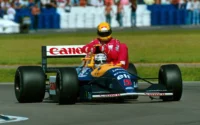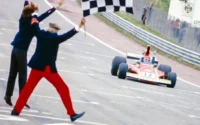Frank Williams had been passionate about motor racing from a young age. After competing in saloon cars and Formula Three, he realised he had reached his peak as a driver. Using his sharp instincts as a dealer in racing cars and spares, Williams shifted to entering other drivers, notably his friend and sometime flatmate Piers Courage. Backing Courage in a successful 1968 Formula Two season, Williams purchased a Brabham Formula 1 car for Courage in 1969. This move reportedly angered Jack Brabham, as the car was intended for the Tasman Series and subsequent conversion to Formula 5000. Nonetheless, Courage had a stellar year, securing second-place finishes at both the 1968 Monaco and US Grand Prix.
Notable Team Members and Drivers
Henri Pescarolo: Pescarolo was a key driver for Frank Williams Racing Cars during the early 1970s racing for the team through three seasons.
Jacques Laffite: Laffite joined the team in 1974, stabilizing the team’s performance during a financially challenging period. His fourth-place finish in Italy and second-place finish in Germany in 1975 brought much-needed financial aid to the team.
Patrick Head: Head joined the team as a young engineer in the mid-1970s and later co-founded Williams Grand Prix Engineering with Frank Williams in 1977.
Their success caught the attention of Italian sports car manufacturer De Tomaso, who built a Formula 1 chassis (designed by Giampaolo Dallara) for the 1970 season. However, the car was initially uncompetitive, failing to finish the first four races. Tragedy struck at the fifth race, the 1970 Dutch Grand Prix, where the De Tomaso 505/38 flipped and caught fire, killing Courage. This deeply affected Williams, and it is believed that this event led him to distance himself emotionally from his drivers in the future. Despite this setback, the team continued with drivers Brian Redman and Tim Schenken, but without success, leading to the dissolution of the partnership with De Tomaso.
In 1971, Williams acquired a year-old March 701 and ran it with Frenchman Henri Pescarolo. The team later upgraded to a new March 711, but results remained elusive. The old car was also entered for Max Jean at the 1971 French Grand Prix. Following the success of 1969, Williams was now struggling financially, living from race to race. Despite the challenges, Pescarolo managed to keep the team afloat with a fourth-place finish at the 1971 British Grand Prix and sixth in Austria.
Frank Williams Racing Cars (1969–1975)
In 1972, French oil company Motul joined Frank Williams Racing Cars as a sponsor, allowing Williams to purchase a new March 721 for driver Henri Pescarolo. Additionally, Italian toy manufacturer Politoys provided funding to build an in-house chassis. Carlos Pace drove the previous year’s March 711 in the non-Championship 1972 Brazilian Grand Prix and later secured fifth place at the 1972 Belgian Grand Prix.
The Len Bailey-designed Politoys FX3 was a conventional Cosworth-engined car with a Hewland FG400 gearbox. It made its debut at the 1972 British Grand Prix with Pescarolo driving, but a steering failure resulted in heavy damage to the car. Pescarolo reverted to the March 721 while the Politoys FX3 was rebuilt. In its final appearance as the Politoys FX3, Chris Amon drove the car at the end-of-season non-Championship 1972 World Championship Victory Race at Brands Hatch. However, he qualified only 20th and retired due to engine failure.
Iso–Marlboro (1973–1974)
At the end of 1972, both Motul and Politoys withdrew their support from Frank Williams Racing Cars. However, for the 1973 season, Williams secured sponsorship from cigarette giant Marlboro and Italian sports car manufacturer Iso Autoveicoli S.p.A. The Politoys FX3 was reworked and rebranded as the Iso–Marlboro FX3B, with a second car built for the team. New drivers Howden Ganley from New Zealand and Italy’s Nanni Galli were signed on.
In the season opener in Argentina, Galli qualified 16th, while Ganley started 19th and last on the grid. Galli’s race ended on the first lap due to engine failure, but Ganley managed to finish, though he was not classified as he was 17 laps behind the winner. The team showed improvement in Brazil, where Ganley finished seventh and Galli ninth. However, Galli was injured while testing a sports car and was replaced by local driver Jackie Pretorius for the next race in South Africa. Pretorius retired mid-race due to overheating issues, while Ganley finished tenth, six laps down.
By this time, the FX3B had become obsolete due to new deformable structure regulations and was replaced by the Iso–Marlboro IR. Nonetheless, the FX3B was used in two non-Championship races. At the 1973 Race of Champions, Tony Trimmer drove an FX3B to a fourth-place finish, while Ganley retired due to handling problems. In the FX3B’s final race, the 1973 BRDC International Trophy, Ganley retired once again, this time due to low oil pressure.
Introduced at the 1973 Spanish Grand Prix, the Iso–Marlboro IR saw eight different drivers during the remainder of the season. Howden Ganley was the only regular driver and managed to score a point at the 1973 Canadian Grand Prix late in the season. Among the other drivers—Nanni Galli, Henri Pescarolo, Tom Belso, Graham McRae, Gijs van Lennep, Tim Schenken, and Jacky Ickx—only van Lennep scored a point, finishing in sixth place at his home race in the Netherlands.
Both Iso Rivolta and Marlboro withdrew their sponsorships before the 1974 season, leaving Frank Williams Racing Cars with financial difficulties. The two IR chassis were retained and re-designated as FW, after Frank Williams. Initially, only one car was entered for Arturo Merzario, who replaced Ganley as the team’s primary driver. Merzario provided an early boost by finishing sixth in the third race of the season in South Africa. When the second car was reintroduced, it was driven by a series of pay drivers with limited success. After three non-qualifications, Jacques Laffite was brought in to partner Merzario, resulting in improved performances, including a fourth-place finish for Merzario in Italy. This earned the team a total of four points and a tenth-place finish in the 1974 Constructors’ Championship. Three Iso–Marlboro FW chassis were used during 1974, named Williams FW01, FW02, and FW03 for 1975, although they were essentially the same.
Merzario and Laffite continued as drivers for the start of the 1975 season, with the team using the FW02 and FW03. Realising the need for a new car, Williams introduced the FW04, the first chassis to carry the Williams name, at the 1975 Spanish Grand Prix. Promising British driver Tony Brise substituted for Laffite, finishing seventh. However, the team’s financial problems worsened, leading to Merzario’s departure after the 1975 Belgian Grand Prix. His seat was filled by six different pay drivers for the rest of the season, including Ian Scheckter, François Migault, Ian Ashley, Jo Vonlanthen, Renzo Zorzi, and Lella Lombardi. Meanwhile, Damien Magee substituted for Laffite in Sweden.
Around this time, Frank Williams signed a young engineer, Patrick Head, who would later become a key partner in forming Williams Grand Prix Engineering in 1977. A significant surprise came in Germany, where Jacques Laffite, secured a second-place finish behind Carlos Reutemann in the Brabham. This result provided much-needed financial relief to the struggling team. Although this was the team’s only points finish of the season, it improved their position in the 1977 Constructors’ Championship to ninth.
Wolf–Williams Racing (1976)
In early 1976, Canadian oil millionaire Walter Wolf acquired 60% of Frank Williams Racing Cars, transforming the team into Wolf–Williams Racing. Despite the change in ownership, Frank Williams remained as the team manager. Soon after the acquisition, Harvey Postlethwaite joined as chief engineer. Concurrently, Wolf purchased the assets of the recently withdrawn Hesketh team.
Operating out of the Williams facility in Reading, the team primarily used cars and equipment from Hesketh Racing. They inherited the Hesketh 308C car from the final races of 1975, rebranding it as the Wolf–Williams FW05. Additionally, the Williams FW04 was rebranded as the Wolf–Williams FW04, though it was only used in the opening race of the season, the 1976 Brazilian Grand Prix.
At the end of the season, Wolf restructured the team by removing Frank Williams from his managerial role. Disillusioned by this change, Williams left the team to establish Williams Grand Prix Engineering, now known as Williams, with Patrick Head in 1977. Wolf then acquired full ownership of Wolf–Williams Racing, which was subsequently renamed Walter Wolf Racing.
Frank Williams Racing Cars Formula One World Championship Records
| First entry | 1969 Spanish Grand Prix |
|---|---|
| Races entered | 105 (96 starts) |
| Constructors’ Championships | 0 |
| Drivers’ Championships | 0 |
| Race victories | 0 |
| Podiums | 3 |
| Points | 12 |
| Pole positions | 0 |
| Fastest laps | 1 |
| Final entry | 1976 Japanese Grand Prix |
Frank Williams Racing Cars Constructors’ Championship Results
| Year | Car | Drivers | Points | WCC |
|---|---|---|---|---|
| 1969 | Brabham BT26A Brabham BT30 | Piers Courage Richard Attwood | – | – |
| 1970 | De Tomaso 505 | Piers Courage Brian Redman Tim Schenken | – | – |
| 1971 | March 701 March 711 | Henri Pescarolo Max Jean | – | – |
| 1972 | March 711 March 721 Politoys FX3 | Carlos Pace Henri Pescarolo | – 0 | – NC |
| 1973 | Iso–Marlboro FX3B Iso–Marlboro IR | Howden Ganley Nanni Galli Jackie Pretorius Tom Belso Henri Pescarolo Graham McRae Gijs van Lennep Tim Schenken Jacky Ickx | 2 | 10th |
| 1974 | Iso–Marlboro FW | Arturo Merzario Richard Robarts Tom Belso Gijs van Lennep Jean-Pierre Jabouille Jacques Laffite | 4 | 10th |
| 1975 | Williams FW Williams FW04 | Arturo Merzario Damien Magee François Migault Ian Ashley Jo Vonlanthen Renzo Zorzi Lella Lombardi Jacques Laffite Tony Brise Ian Scheckter | 6 | 9th |
| 1976 | Wolf–Williams FW04 Wolf–Williams FW05 | Jacky Ickx Arturo Merzario Renzo Zorzi Michel Leclère Chris Amon Warwick Brown Hans Binder Masami Kuwashima | 0 | NC |
| Williams FW04 | Emilio Zapico | 0 | NC |
Frank Williams Racing Cars Non-Championship Entries
| Year | Car | Drivers |
|---|---|---|
| 1969 | Brabham BT26A | Piers Courage |
| 1970 | De Tomaso 505 | Piers Courage Tim Schenken |
| 1971 | March 701 March 711 | Ray Allen Derek Bell Cyd Williams Tony Trimmer Henri Pescarolo Ronnie Peterson |
| 1972 | March 711 March 721 Politoys FX3 | Carlos Pace Henri Pescarolo Chris Amon |
| 1973 | Iso–Marlboro FX3B Iso–Marlboro IR | Tony Trimmer Howden Ganley |
| 1974 | Iso–Marlboro FW | Arturo Merzario |
| 1975 | Williams FW03 | Arturo Merzario Maurizio Flammini Jacques Laffite Jo Vonlanthen |
| 1976 | Wolf–Williams FW05 | Jacky Ickx Mario Andretti |
Source: Wikipedia.com


